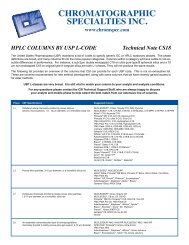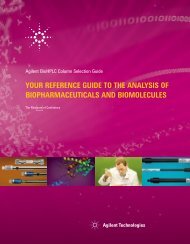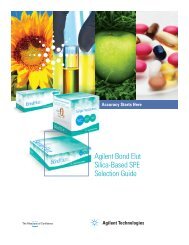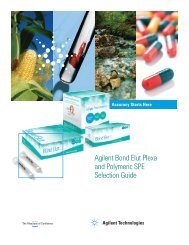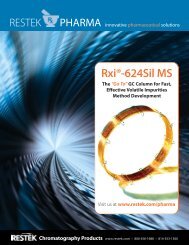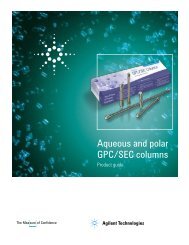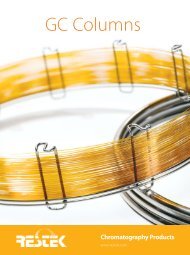Optimizing the Analysis of Volatile Organic Compounds
Optimizing the Analysis of Volatile Organic Compounds
Optimizing the Analysis of Volatile Organic Compounds
Create successful ePaper yourself
Turn your PDF publications into a flip-book with our unique Google optimized e-Paper software.
2<br />
Table <strong>of</strong> Contents<br />
EPA Method Definitions . . . . . . . . . . . . . . . . . . . . .3<br />
Drinking Water Methods (500 Series) . . . . . . . . .3<br />
Wastewater Methods (600 Series) . . . . . . . . . . . .3<br />
Hazardous Waste Methods (8000 Series) . . . . . . .4<br />
State GRO Methods . . . . . . . . . . . . . . . . . . . . . . . .4<br />
Contract Laboratory Program (CLP) . . . . . . . . . . . .5<br />
The Love Canal Scandal . . . . . . . . . . . . . . . . . . . .6<br />
Purge and Trap Theory . . . . . . . . . . . . . . . . . . . . .7<br />
Concentration <strong>of</strong> <strong>Volatile</strong> <strong>Organic</strong>s . . . . . . . . . . .7<br />
Sequences and Flow Paths <strong>of</strong><br />
<strong>the</strong> Purge and Trap Unit . . . . . . . . . . . . . . . . . . . . .8<br />
Purge and Trap Components . . . . . . . . . . . . . . . . .9<br />
Purge Vessel . . . . . . . . . . . . . . . . . . . . . . . . . . .9<br />
Valves . . . . . . . . . . . . . . . . . . . . . . . . . . . . . . .10<br />
Adsorbent Materials and Traps . . . . . . . . . . . . . . .10<br />
Adsorbent Materials . . . . . . . . . . . . . . . . . . . . .11<br />
Choosing <strong>the</strong> Right Trap for Your <strong>Analysis</strong> . . . . .12<br />
Moisture Control Systems-<br />
Water and Methanol Management . . . . . . . . . . .13<br />
Transfer Line . . . . . . . . . . . . . . . . . . . . . . . . . . .14<br />
Troubleshooting Common Problems<br />
Associated with Purge and Trap Units . . . . . . . . .15<br />
GC System Configurations . . . . . . . . . . . . . . . . . .18<br />
Wide-bore Systems<br />
(0.45mm ID and 0.53mm ID columns) . . . . . . . .18<br />
Narrow-bore Systems<br />
(0.18mm ID - 0.32mm ID columns) . . . . . . . . . .21<br />
Capillary Column Phases . . . . . . . . . . . . . . . . .21<br />
Metal Columns . . . . . . . . . . . . . . . . . . . . . . . . .22<br />
Detection Systems . . . . . . . . . . . . . . . . . . . . . . . .23<br />
Column Configurations . . . . . . . . . . . . . . . . . . .23<br />
Detector Configurations . . . . . . . . . . . . . . . . . .23<br />
PID Operation . . . . . . . . . . . . . . . . . . . . . . . . . .24<br />
FID Operation . . . . . . . . . . . . . . . . . . . . . . . . . .25<br />
ELCD Operation . . . . . . . . . . . . . . . . . . . . . . . .26<br />
GC/MS Operation . . . . . . . . . . . . . . . . . . . . . . . .30<br />
Applications Using GC Detection Systems . . . . . .37<br />
Applications Using GC/MS Detection Systems . . .50<br />
Tables <strong>of</strong> Retention Times . . . . . . . . . . . . . . . . . .56<br />
Conclusion . . . . . . . . . . . . . . . . . . . . . . . . . . . . .60<br />
Products . . . . . . . . . . . . . . . . . . . . . . . . . . . . . . .61<br />
Product Index . . . . . . . . . . . . . . . . . . . . . . . . . .61<br />
www.restekcorp.com<br />
Introduction<br />
<strong>Optimizing</strong> <strong>the</strong> <strong>Analysis</strong> <strong>of</strong> <strong>Volatile</strong> <strong>Organic</strong> <strong>Compounds</strong><br />
One <strong>of</strong> our standing goals is to provide you with practical technical information to help you<br />
obtain reliable data from your chromatographic and peripheral systems. This guide presents<br />
information on <strong>the</strong> common US Environmental Protection Agency (EPA) gas chromatography<br />
(GC) methods and procedures used to analyze volatile organic compounds (VOCs). It is<br />
a compilation <strong>of</strong> information based on our experience and that <strong>of</strong> experts in this field. Much<br />
<strong>of</strong> this guide is dedicated to discussing purge and trap techniques, and showing applications<br />
using a variety <strong>of</strong> configurations and conditions.<br />
We would like to thank <strong>the</strong> following people for <strong>the</strong>ir technical contributions to this guide:<br />
Jessie Crocket Butler, Applications Chemist<br />
Thermo Finnigan, GC & GC/MS Division<br />
2215 Grand Avenue Pkwy<br />
Austin, Texas 78728<br />
Laura Chambers, Applications Chemist<br />
OI Corporation<br />
151 Graham Road<br />
College Station, Texas 77845<br />
Jeff Grindstaff, GC/MS Manager<br />
Columbia Analytical<br />
1317 South 13th Avenue<br />
Kelso, Washington 98626<br />
Alan Hilling, Lab Supervisor<br />
Pace Analytical Services Inc.<br />
9800 Kincey Avenue, Suite 100<br />
Huntersville, North Carolina 28078<br />
Darrell Robbins, GC/MS <strong>Volatile</strong>s Chemist<br />
Severn Trent Laboratories<br />
55 South Park Drive<br />
Colchester, Vermont 05446<br />
Glynda Smith, Applications Chemist<br />
Tekmar-Dohrmann<br />
4736 Socialville-Foster Road<br />
Mason, Ohio 45040<br />
Alex Tam, GC/MS <strong>Volatile</strong>s Chemist<br />
Severn Trent Laboratories<br />
1220 Quarry Lane<br />
Pleasanton, California 94566<br />
We hope you enjoy reading this guide and find it useful in your work. If you have any questions,<br />
or have input for future editions, please don’t hesitate to contact Restek Corporation -<br />
we’ll be happy to hear from you.<br />
Christopher English<br />
Environmental Innovations Specialist





